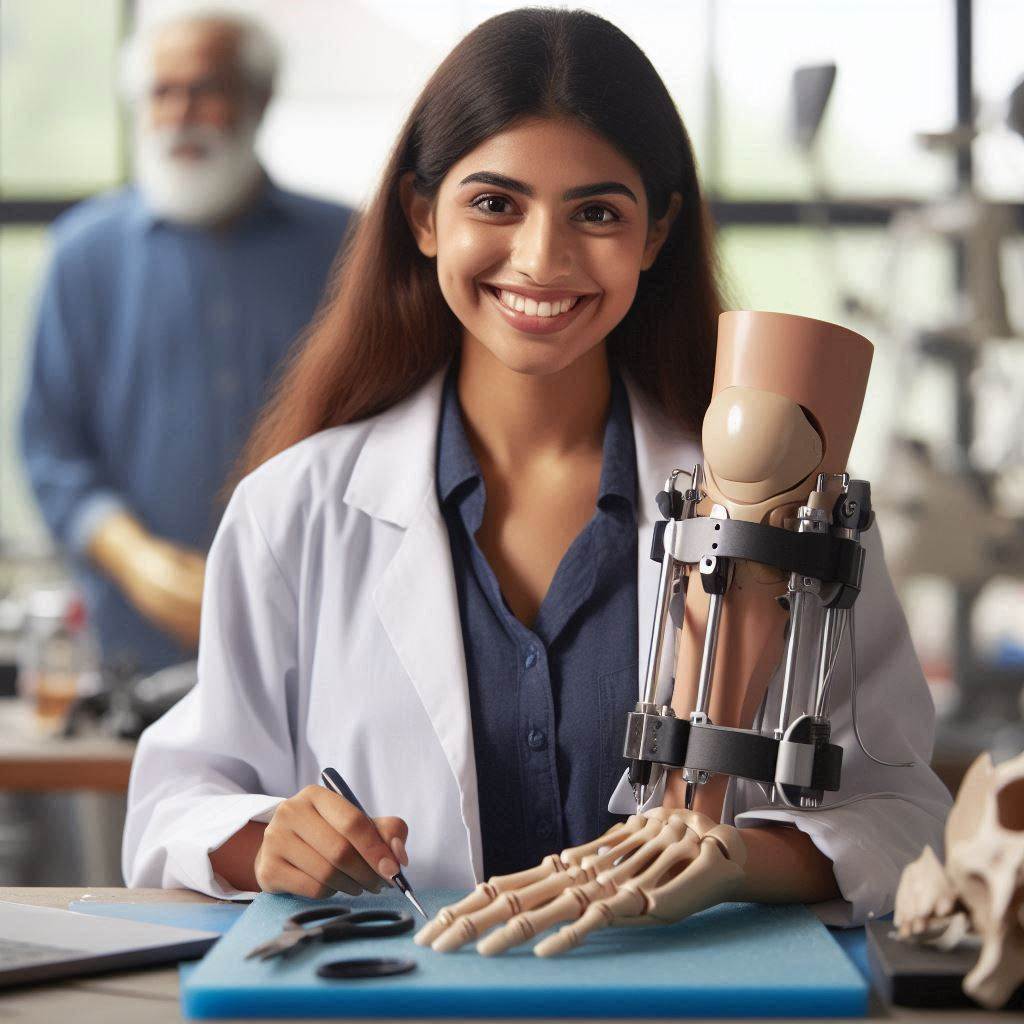Introduction
Orthotics and Prosthetics Trends: Orthotics and prosthetics play a crucial role in modern healthcare, offering customized solutions that enhance mobility, comfort, and quality of life for millions worldwide.
As technology continues to evolve, so too does the field of orthotics and prosthetics, bringing forth innovations that promise to revolutionize patient care.
This blog explores the exciting future trends that are set to shape the landscape of orthotics and prosthetics in the coming years.
Advancements in technology have already begun to redefine what is possible in this field.
From 3D printing to advanced materials and smart sensors, these technologies are enabling unprecedented levels of customization and functionality in orthotic and prosthetic devices.
Patients are now benefiting from lighter, more durable materials that improve comfort and performance, while healthcare professionals can tailor solutions with greater precision than ever before.
Trends to Watch
In this blog post, we will delve into several key trends driving the future of orthotics and prosthetics:
- Personalized 3D-Printed Devices: 3D printing has revolutionized the manufacturing process, allowing for bespoke orthotic and prosthetic devices that perfectly match the individual anatomy of each patient. This customization not only improves comfort but also enhances effectiveness and accelerates rehabilitation.
- Advanced Materials and Design: Innovations in materials science are leading to lighter, stronger, and more flexible materials that mimic natural human tissue. These materials not only improve the functionality of devices but also increase durability and reduce the risk of skin irritation.
- Integration of Smart Technology: The integration of sensors and microprocessors into orthotic and prosthetic devices is transforming them into intelligent systems. These smart devices can monitor gait patterns, adjust in real-time to changes in movement, and provide valuable data to healthcare providers for optimizing treatment plans.
- Telehealth and Remote Monitoring: Telehealth technologies are making it easier for patients to access orthotic and prosthetic care remotely. From initial consultations to ongoing monitoring and adjustments, telehealth solutions are enhancing convenience and accessibility for patients in remote or underserved areas.
As we look to the future, the field of orthotics and prosthetics is poised for remarkable advancements driven by technology and innovation.
By embracing these trends, healthcare professionals can continue to improve patient outcomes and quality of life.
Stay tuned as we explore each of these trends in depth, highlighting their potential impact on the future of orthotics and prosthetics.
3D Printing Technology
In the rapidly evolving field of orthotics and prosthetics, 3D printing technology has emerged as a revolutionary force, promising transformative changes in manufacturing processes and patient care.
This innovative approach not only enhances customization but also accelerates production timelines while maintaining cost-effectiveness.
Revolutionizing Manufacturing Processes
Traditionally, crafting orthotic and prosthetic devices required labor-intensive methods that often resulted in standardized products.
However, with 3D printing, manufacturers can create personalized devices tailored to individual patient needs.
By using detailed digital scans, practitioners can precisely design prosthetics and orthotics that fit the patient’s anatomy with unprecedented accuracy.
Benefits of 3D Printing
The advantages of 3D printing in orthotics and prosthetics are manifold.
Firstly, customization is significantly improved, allowing for adjustments that meet the unique anatomical requirements of each patient.
This level of personalization enhances comfort and functionality, ultimately improving patient outcomes.
Secondly, 3D printing enables faster production times compared to traditional methods, reducing wait times for patients in need of prosthetic or orthotic devices.
Moreover, the cost-effectiveness of 3D printing has made these advanced technologies more accessible, promising broader adoption and affordability for patients and healthcare providers alike.
Transform Your Career Today
Unlock a personalized career strategy that drives real results. Get tailored advice and a roadmap designed just for you.
Start NowSuccessful Applications in the Field
Several notable examples illustrate the successful integration of 3D printing in orthotics and prosthetics.
In the realm of prosthetics, companies like Open Bionics have pioneered the development of affordable, 3D-printed bionic hands that are not only functional but also aesthetically pleasing.
These devices can be customized quickly to match individual preferences and functional needs, providing a higher quality of life for users worldwide.
In orthotics, 3D printing has revolutionized the design and production of supportive braces and splints.
Companies such as UNYQ have leveraged this technology to create stylish and functional orthotic wearables that blend seamlessly into daily life while offering superior support and comfort.
In essence, the future of orthotics and prosthetics is undeniably intertwined with the evolution of 3D printing technology.
As advancements continue to unfold, patients can expect more personalized, efficient, and affordable solutions that enhance mobility, comfort, and overall quality of life.
This section succinctly captures the transformative impact of 3D printing on orthotics and prosthetics, highlighting its benefits and real-world applications.
If you need any adjustments or further details, feel free to ask!
Read: Networking Tips for Aspiring Public Health Administrators
Artificial Intelligence in Design: Revolutionizing Orthotics and Prosthetics
Artificial intelligence (AI) is rapidly transforming the landscape of orthotics and prosthetics, ushering in a new era of innovation and efficiency.
By harnessing the power of AI, designers and healthcare professionals are pioneering advancements that promise to significantly enhance patient care and device functionality.
Designing Efficient and Functional Devices
AI’s role in designing orthotic and prosthetic devices goes beyond traditional methods.
Machine learning algorithms analyze vast datasets of patient biomechanics, preferences, and historical performance of devices.
This data-driven approach allows AI to generate designs that are not only tailored to individual needs but also optimized for comfort and performance.
By simulating various design iterations, AI helps designers refine prototypes faster and more accurately than ever before.
Improving Patient Outcomes
One of the most compelling advantages of AI in orthotics and prosthetics is its impact on patient outcomes.
AI-powered devices can adapt in real-time to changes in a patient’s gait, posture, or physical condition.
This adaptive capability reduces the need for frequent adjustments and improves device fit and comfort.
Showcase Your Business Today
Reach thousands of readers actively exploring professional services. Publish your business profile and grow your audience now.
Publish NowMoreover, AI algorithms continuously learn from patient feedback and physiological data, enabling personalized adjustments that enhance overall satisfaction and functionality.
Case Studies and Research Insights
Research studies underscore the transformative potential of AI in this field.
For instance, a recent study published in Journal of Prosthetics and Orthotics demonstrated that AI-driven prosthetic limbs adjusted more intuitively to user movements, significantly reducing the learning curve for new users.
Similarly, advancements in AI-driven orthotic braces have shown promising results in providing optimal support and alignment for patients with specific mobility challenges.
Looking Ahead
As AI continues to evolve, so too will its applications in orthotics and prosthetics.
Future innovations may include predictive modeling to anticipate device wear and tear, further improving longevity and cost-effectiveness.
Moreover, collaborative efforts between AI developers, healthcare providers, and patients will drive the next wave of innovations, ensuring that AI-powered devices not only meet but exceed the expectations of users worldwide.
In essence, AI is not just transforming the design process of orthotics and prosthetics; it is redefining the possibilities for enhancing patient care and quality of life.
By integrating AI-driven technologies into everyday practice, healthcare professionals are poised to deliver more personalized, efficient, and effective solutions to meet the diverse needs of patients across the globe.
Read: Orthotist/Prosthetist Community Outreach and Advocacy

Smart Devices and Wearables
The orthotics and prosthetics industry has seen a significant rise in the use of smart devices and wearables in recent years.
These innovative technologies have revolutionized the way patients receive care and how practitioners deliver it.
Enhancing Patient Comfort and Mobility
Smart devices and wearables have greatly enhanced patient comfort and mobility.
By incorporating sensors and advanced technology, these devices can provide real-time feedback and adjustments to ensure optimal support and function.
For example, smart knee braces can detect changes in gait and adjust resistance levels accordingly, providing a more personalized and adaptive solution for users.
This leads to improved stability, reduced pain, and increased mobility for individuals with knee injuries or conditions.
Improving Overall Quality of Life
These technologies are not only focused on physical support but also on improving the overall quality of life for individuals with orthotic and prosthetic needs.
By offering features like remote monitoring, activity tracking, and data sharing capabilities, smart devices empower patients to take control of their health and well-being.
For instance, smart prosthetic limbs are equipped with sensors that can detect movement patterns and adjust grip strength based on the task at hand.
This level of customization and functionality allows users to perform daily activities more efficiently and with greater ease.
Popular Smart Orthotic and Prosthetic Devices
There are several popular smart orthotic and prosthetic devices available in the market today, each offering unique benefits and features:
- Ottobock C-Brace: This smart knee orthosis utilizes sensor technology to adapt to various movements and walking patterns, providing dynamic support and stability.
- Össur PROPRIO FOOT: This smart prosthetic foot mimics the natural movement of the ankle, allowing for a more natural gait and smoother transitions between different surfaces.
- Blatchford Linx: This smart prosthetic limb features integrated microprocessor control that adjusts the alignment and function of the limb in response to the user’s activity level.
- Sensoria Smart Socks: These smart socks have embedded textile pressure sensors that provide real-time feedback on foot pressure distribution, helping prevent injuries and improve balance.
In a nutshell, the integration of smart devices and wearables in orthotics and prosthetics is a game-changer for both patients and practitioners.
These technologies offer personalized solutions, improved comfort, enhanced mobility, and ultimately, a better quality of life for individuals with orthotic and prosthetic needs.
Read: Public Health Administration: Key Challenges and Solutions
Remote Monitoring and Telehealth
In the evolving landscape of healthcare, remote monitoring and telehealth have emerged as transformative forces, particularly within the realm of orthotics and prosthetics.
These technologies represent a paradigm shift, offering unprecedented avenues for patient care and management.
Role in Patient Care
Remote monitoring and telehealth play a pivotal role in enhancing patient care in orthotics and prosthetics.
By leveraging wearable devices and advanced sensors, healthcare providers can remotely track crucial metrics such as gait patterns, prosthetic usage, and biomechanical data.
This real-time information allows for proactive adjustments and personalized interventions, ensuring optimal functionality and comfort for patients.
Enabling Remote Adjustments
One of the hallmark benefits of these technologies is their ability to facilitate remote adjustments.
Traditionally, patients would need multiple in-person visits to fine-tune prosthetic fittings or orthotic alignments.
With remote monitoring, healthcare providers can analyze data remotely and make necessary adjustments promptly.
This not only reduces the inconvenience and costs associated with frequent clinic visits but also empowers patients to receive timely care regardless of their geographical location.
Benefits for Patients
The benefits of remote monitoring extend beyond efficiency.
Patients experience increased accessibility to specialized care, especially those in rural or underserved areas where access to prosthetic and orthotic expertise may be limited.
Moreover, the convenience of monitoring from home fosters a sense of empowerment and independence among patients, enhancing their overall quality of life.
Therefore, remote monitoring and telehealth are reshaping the orthotics and prosthetics landscape by bridging gaps in accessibility, improving patient outcomes, and redefining the standards of care delivery.
As these technologies continue to evolve, their integration into everyday practice promises to unlock new possibilities for personalized, efficient healthcare.
Embracing these innovations ensures that patients receive the timely adjustments and support they need, ultimately fostering a future where healthcare is not only effective but also accessible to all.
Read: How Technology is Transforming Orthotics and Prosthetics
Showcase Your Business Today
Reach thousands of readers actively exploring professional services. Publish your business profile and grow your audience now.
Publish NowSustainability and Biodegradable Materials
As the world becomes more environmentally conscious, the orthotics and prosthetics industry is also shifting towards sustainable practices.
Traditional materials used in orthotics and prosthetics, such as plastics and metals, have a significant environmental impact.
The production and disposal of these materials can contribute to pollution, landfill waste, and greenhouse gas emissions.
By switching to eco-friendly alternatives, such as biodegradable materials, the industry can reduce its carbon footprint and lessen its environmental impact.
Biodegradable materials are designed to break down naturally over time, reducing the amount of waste that ends up in landfills.
These materials are typically made from plant-based polymers, which are renewable resources that can be sustainably sourced.
In addition to being better for the environment, biodegradable materials can also be beneficial for patients who use orthotics and prosthetics.
Some patients may have allergies or sensitivities to traditional materials, so using biodegradable materials can help avoid any adverse reactions.
Companies Leading the Way
Several companies and organizations are at the forefront of utilizing sustainable practices and biodegradable materials in orthotics and prosthetics.
One notable example is Össur, a leading global provider of non-invasive orthopedics, which has made significant strides in sustainability.
Össur has implemented eco-friendly manufacturing processes and uses recycled materials in their products to reduce waste and energy consumption.
Another innovative company is UNYQ, which creates personalized prosthetic covers using 3D printing technology and sustainable materials.
UNYQ’s covers are not only customizable and stylish but also environmentally friendly, showcasing the possibilities of sustainable orthotics and prosthetics.
Other companies, such as Fillauer and Ottobock, are also exploring the use of biodegradable materials in their products to promote sustainability.
These companies are setting a positive example for the industry and inspiring others to prioritize sustainability in orthotics and prosthetics.
Basically, the shift towards sustainable practices and the use of biodegradable materials in orthotics and prosthetics is a positive trend to watch.
By embracing eco-friendly alternatives, companies can reduce their environmental impact and provide patients with safer and more sustainable solutions.
Conclusion
The field of orthotics and prosthetics is poised for remarkable advancements driven by several key trends.
Technological innovations, such as 3D printing and advanced materials, are revolutionizing how orthotic and prosthetic devices are designed and manufactured.
These technologies not only enhance customization and precision but also improve comfort and functionality for patients.
Moreover, the integration of AI and machine learning is transforming patient care by enabling predictive analytics and personalized treatment plans.
These tools empower practitioners to tailor orthotic and prosthetic solutions more precisely to individual patient needs, leading to better outcomes and increased patient satisfaction.
The emphasis on sustainability is another crucial trend shaping the future of orthotics and prosthetics.
As awareness grows regarding environmental impact, there is a shift towards developing eco-friendly materials and sustainable practices in device production.
This not only supports environmental conservation but also aligns with patient preferences for ethical healthcare solutions.
Staying updated with these trends is essential for healthcare professionals in the orthotics and prosthetics field.
By embracing new technologies and practices, practitioners can deliver the highest standard of care to their patients, enhancing mobility, comfort, and overall quality of life.
[E-Books for Sale]
The Big Book of 500 High-Paying Jobs in America: Unlock Your Earning Potential
$19.99 • 500 High-Paying Jobs • 330 pages
Explore 500 high-paying jobs in America and learn how to boost your career, earn more, and achieve success!
See All 500 High-Paying Jobs of this E-Book
1001 Professions Without a Degree: High-Paying American Jobs You Can Start Now
$19.99 • 1001 Professions Without a Degree • 174 pages
Discover 1001 high-paying jobs without a degree! Unlock career tips, skills, and success strategies for just $19.99!




